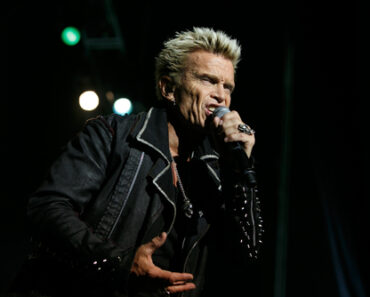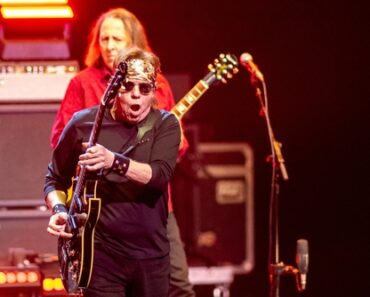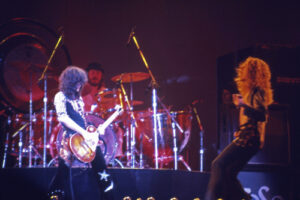
Feature Photo: Karin Hildebrand Lau / Shutterstock.com
Crosby, Stills, Nash & Young transformed folk rock by merging introspective songwriting with electrifying instrumentation and intricate vocal harmonies, creating a sound that defined a generation. Formed in 1968, the group brought together David Crosby of The Byrds, Stephen Stills of Buffalo Springfield, and Graham Nash of The Hollies. Their collective talents combined West Coast folk sensibilities, British pop craftsmanship, and an adventurous rock ethos. Neil Young joined the trio shortly thereafter, adding his distinctive songwriting and guitar work to elevate their artistry even further.
The band’s debut album, Crosby, Stills & Nash, released in 1969, immediately set them apart with its lush harmonies and timeless tracks like “Suite: Judy Blue Eyes” and “Marrakesh Express.” This album solidified their reputation as a force in the burgeoning countercultural movement, blending personal reflection with the political consciousness of the era. The addition of Neil Young brought a harder edge to their sound, culminating in the groundbreaking Déjà Vu in 1970, which included enduring classics like “Teach Your Children” and “Woodstock.” This record went multi-platinum, reflecting the group’s ability to connect deeply with audiences.
Crosby, Stills, Nash & Young’s live performances further cemented their legacy. Their electrifying set at Woodstock in 1969 captured the spirit of the festival and showcased their ability to seamlessly transition between acoustic and electric arrangements. Songs like “Ohio,” written by Neil Young in response to the Kent State shootings, demonstrated their willingness to address societal issues head-on. This ability to blend activism with artistry became one of the group’s defining characteristics.
Across their career, CSNY released several albums together and as individuals, creating an extensive body of work that includes 4 Way Street, a live album that captured the raw power and intricate musicianship of their concerts. The members’ solo ventures, including Neil Young’s Harvest and David Crosby’s If I Could Only Remember My Name, further enriched their collective legacy, each contributing singular perspectives while maintaining a shared ethos of innovation.
The group’s accolades include Grammy Awards, inductions into the Rock and Roll Hall of Fame (both collectively and individually), and recognition for their influence on subsequent generations of musicians. Beyond music, the members have engaged in activism, with Graham Nash co-founding Musicians United for Safe Energy and Neil Young tirelessly advocating for environmental causes and indigenous rights. Their commitment to blending artistry with social responsibility set a standard few have matched.
What makes Crosby, Stills, Nash & Young so beloved is their ability to articulate the struggles and hopes of their time through rich, emotional songwriting and a dynamic musical interplay. Their harmonies are iconic, their lyrics resonate across decades, and their willingness to address issues of war, peace, and human connection ensures their relevance in every era.
This article showcases their most rocking numbers, so plenty of their most iconic songs will be missing from this list, but that’s okay. We’ve already done those articles on this amazing band. This one is about their ability to rock just as hard as anyone else.
# 10 – Stand and Be Counted – Looking Forward
With an unflinching call for courage and accountability, “Stand and Be Counted” channels the rich legacy of activism and social awareness that Crosby, Stills, Nash & Young are known for. This track from their 1999 album Looking Forward resonates with themes of individual bravery and collective responsibility, tying seamlessly into the group’s ethos of confronting societal challenges head-on through music. Written by David Crosby, the song was recorded during sessions spanning 1998 and 1999, with production helmed by CSNY alongside Joe Vitale and Stanley Johnston. The album itself marked a reunion for the group, and this song highlights their timeless ability to address contemporary issues with emotional resonance.
# 9 – Dark Star – CSN
“Dark Star” emerges as a brooding centerpiece on CSN, Crosby, Stills & Nash’s 1977 album, delivering a moody and electrifying performance that underscores the band’s mastery of intricate vocal harmonies and emotive instrumentation. Written by Stephen Stills, the song was recorded at Criteria Studios in Miami, Florida, with production overseen by the trio and Ron Albert. The album marked the group’s first release after a lengthy hiatus, and “Dark Star” stands out for its powerful blend of introspection and dynamic musicality.
# 8 – Carry On – Deja Vu
“Carry On” opens Déjà Vu with a surge of rhythmic vitality, signaling the electrifying chemistry of Crosby, Stills, Nash & Young as they forged one of rock’s most celebrated albums. Written by Stephen Stills, the track was crafted at Wally Heider Studios in San Francisco and Hollywood in 1969, with Neil Young, David Crosby, and Graham Nash joining Stills in co-producing the record. Drawing on Stills’ knack for blending folk sensibilities with rock energy, “Carry On” merges intricate vocal harmonies, dynamic instrumental shifts, and thought-provoking lyrics into a composition that epitomizes the band’s collaborative brilliance.
# 7 – Deja Vu – Deja Vu
“Déjà Vu,” the title track of Crosby, Stills, Nash & Young’s landmark album Déjà Vu, delves into the enigmatic concept of cyclical existence and collective memory, channeling its mystique into one of the band’s most musically intricate and lyrically thought-provoking compositions. Written by David Crosby and recorded between July 1969 and January 1970 at Wally Heider Studios in Los Angeles, the track embodies the experimental and boundary-pushing ethos that defined the band’s collaboration during this period. Produced by Crosby, Stephen Stills, Graham Nash, and Neil Young, the song combines folk rock roots with psychedelic and jazz influences, resulting in a richly layered soundscape.
# 6 – Long Time Gone – Crosby, Stills & Nash
“Long Time Gone,” an electrifying track from Crosby, Stills & Nash’s self-titled debut album, encapsulates the political and social turmoil of the late 1960s while showcasing the band’s unmatched ability to blend poignant lyrics with intricate harmonies. Written by David Crosby in response to the assassination of Robert F. Kennedy, the song captures the frustration, anger, and yearning for change that defined an era. Recorded in 1969 at Wally Heider Studios in Los Angeles, the track was co-produced by Crosby, Stills, and Nash alongside Bill Halverson, ensuring a polished yet raw sound that remains timeless.
# 5 – Southern Cross – Daylight Again
“Southern Cross,” a centerpiece of Daylight Again, offers an enchanting blend of seafaring imagery and emotional introspection, marking one of Crosby, Stills & Nash’s most enduring contributions to rock music. Written by Stephen Stills alongside Richard Curtis and Michael Curtis, the track was recorded in 1981 and released in 1982 as one of the standout singles from the album. Produced by Crosby, Stills & Nash alongside Stanley Johnston and Steve Gursky, “Southern Cross” achieved commercial success, reaching No. 18 on the Billboard Hot 100, and remains a timeless anthem of personal reflection and exploration.
# 4 – Ohio (Live Version) – 4 Way Street
The live version of “Ohio” from 4 Way Street captures the raw, incendiary energy of one of Crosby, Stills, Nash & Young’s most politically charged anthems. Written by Neil Young in response to the tragic Kent State shootings on May 4, 1970, the song became an enduring symbol of protest against governmental violence. The live recording, part of their 4 Way Street album released in April 1971, magnifies the song’s visceral power, turning it into an electrifying communal experience that resonated with the countercultural movements of the time.
# 3 – Woodstock – Crosby, Stills & Nash
Joni Mitchell’s poetic ode to the iconic music festival finds its most electrifying interpretation in Crosby, Stills, Nash & Young’s version of “Woodstock,” released on their 1970 album Déjà Vu. While Mitchell’s original captures a reflective and melancholic tone, CSN&Y transforms the song into an anthemic celebration, driven by soaring harmonies and Neil Young’s electrifying guitar work. Recorded in 1969 and produced by the band alongside Bill Halverson, the track epitomizes the communal spirit of the counterculture movement, fusing lyrical idealism with a gritty, rock-driven arrangement.
# 2 – Suite: Judy Blue Eyes – Crosby, Stills & Nash
The quintessential showcase of Crosby, Stills & Nash’s harmonic brilliance, “Suite: Judy Blue Eyes” is both a technical masterpiece and an emotional tour de force. Released as the opening track on their self-titled 1969 debut album, this multi-part composition was written by Stephen Stills as a tribute to his former girlfriend, Judy Collins. Recorded at Wally Heider Studios in Los Angeles with the band producing alongside Bill Halverson, the song’s intricate structure and soaring melodies introduced the world to the unique blend of rock, folk, and pop that defined CSN’s sound.
# 1 – Almost Cut My Hair – Deja Vu
Closing this list with raw emotion and unapologetic defiance, “Almost Cut My Hair” captures the ethos of 1960s counterculture with unflinching honesty. Featured on Déjà Vu (1970), this David Crosby-penned track is a visceral reaction to societal expectations, personal identity, and the judgment of appearances during a time of political and cultural upheaval. Recorded at Wally Heider Studios in San Francisco and Los Angeles, the song showcases the collective power of CSNY, with Crosby’s searing vocals and Neil Young’s fiery guitar interludes creating a palpable sense of urgency. Produced by the band alongside Bill Halverson, this track exemplifies their ability to channel individual expression into a cohesive and impactful statement.
Check out more Crosby, Stills, Nash, And Young articles on ClassicRockHistory.com
Top 10 Crosby, Stills, Nash & Young Songs
Complete List Of Crosby, Stills, Nash & Young Albums
Complete List Of Crosby, Stills & Nash Albums And Songs
Top 10 Crosby, Stills & Nash Songs
Top 10 Neil Young Songs
10 Essential David Crosby Tracks
Top 10 Graham Nash Songs
10 Essential Stephen Stills Songs In Chronological Order
Read More: Artists’ Interviews Directory At ClassicRockHistory.com
Read More: Classic Rock Bands List And Directory
Updated June 8 2025



































